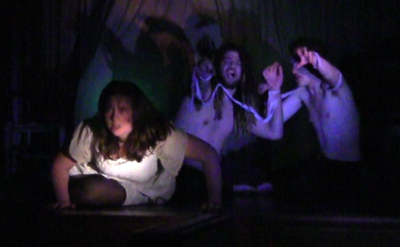
IRIS login | Reed College home Volume 96, No. 2: June 2017
Through Hell and Lunacy
Love, loss, and lunacy forged a powerful combination in the Eliot Hall chapel this semester with a production of The Balance, directed by Elizabeth Dinkova '13 and written with Jane Doerflinger '13.
The play is adapted from Hans Christen Andersen's fairytale "The Story of a Mother," interwoven with the eerie ramblings of a patient in a lunatic asylum. Although Andersen is most famous for his children's stories such as "The Little Mermaid" and "The Ugly Duckling," many of his characters are dark and complex and seldom enjoy happy endings.
"The Story of a Mother" chronicles the journey of a desperate mother whose child is taken by Death and who travels through hell to try to save him. The Balance weaves together this story with that of a psychiatric patient who believes he holds the battle of good and evil in his hands, and refuses to move or speak lest he tips the balance.
"As a child I was baffled by Hans Christian Andersen's sad endings, always wanting more from the writer who kept on evading convention. The decision to transform his "Story of a Mother" into a play about a personal tragedy came as a belated resolution to my childhood confusion," Elizabeth explained.
Dagny Wise '13 was cast perfectly into the role of the ill-fated mother who endures trial after trial, from singing sweet lullabies to the Night, to giving up her warmth to the Bush and her eyes to the Lake, all so that she could find out where Death has taken her son. Likewise Tristen Nieto '13 did a masterful job in conveying two complex characters: Nathaniel Lind, the asylum patient rejected by his seemingly callous wife, and Death, a servant of God in charge of taking away unfulfilled lives. Ironically, trying to find the balance between these two characters, and the two intertwined plotlines into a coherent visual and thematic whole proved to be the greatest challenge for Elizabeth and her crew.
"Using the same actors in both the world of the asylum and the world of the fairytale was the most obvious way in which I tried to convey the correspondences. I wanted to make Nathaniel's interpretative lens consistent and clear in the transformation of asylum events into fairytale trials. My production team and I spent a lot of time playing with how to represent the Night, the Lake, and the Bush without slipping into anything contrived or cliché. Endowing the trials with a visceral kind of meaning led to sometimes disturbing but effective results."
Indeed the results were sometimes disconcerting. The scene where the mother is forced to give up her warmth to a freezing thorn bush, played by Colin Trevor '15 and Andrew Watson '14, was almost rape-like in nature. Her whole body was enveloped by the two-headed bush, as her pitched screams for help went unanswered.
Minimalist lighting was used throughout the play--some scenes were actually illuminated by flashlights, creating an ambience of menace. The play ended on a tenuous note, with the mother finally accepting God's plan for her child. However no matter how difficult circumstances become, hope lives on, even if it just means finding the strength to believe in oneself, a lost cause, or as Elizabeth says, "the beauty within darkness and catastrophe."



LATEST COMMENTS
steve-jobs-1976 I knew Steve Jobs when he was on the second floor of Quincy. (Fall...
Utnapishtim - 2 weeks ago
Prof. Mason Drukman [political science 1964–70] This is gold, pure gold. God bless, Prof. Drukman.
puredog - 1 month ago
virginia-davis-1965 Such a good friend & compatriot in the day of Satyricon...
czarchasm - 4 months ago
John Peara Baba 1990 John died of a broken heart from losing his mom and then his...
kodachrome - 7 months ago
Carol Sawyer 1962 Who wrote this obit? I'm writing something about Carol Sawyer...
MsLaurie Pepper - 8 months ago
William W. Wissman MAT 1969 ...and THREE sisters. Sabra, the oldest, Mary, the middle, and...
riclf - 10 months ago